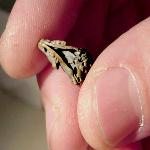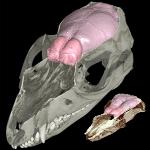May 19, 2011

Photo: Mark A. Klingler/Carnegie Museum of Natural History
The fossil of the Jurassic mammal Hadrocodium wui - its skull is only 12 millimeters long and estimated to weigh just 2 grams.
Mammals have much bigger brains than other animals. Scientists aren't sure exactly why, but new research published this week in the journal Science suggests it might have something to do with mammals' acute sense of smell.
Researchers used computed tomography or CT scans to analyze the skulls of 190-million-year-old mammals found in a Jurassic-era fossil bed in China. These tiny critters, co-existed with the giant, meat-eating dinosaurs and probably survived by being nocturnal.
But to be active at night meant the mammals had to have "very special sensory adaptations," says Zhe-Xi Luo, a paleontologist at the Carnegie Museum of Natural History in Pittsburgh, Pennsylvania, and a member of the research team that studied the prehistoric mammal skulls.

Matthew Colbert, University of Texas
Jurassic mammals already had a large olfactory bulb for a sophisticated sense of smell.
He says the CT-scans helped the team construct a virtual brain case for two of the ancient mammals. "In this study we have found that the large brain is becoming larger primarily because the olfactory, or the smelling part of the brain, become very big and also the part related to skin tactile sensation also becomes big."
Luo says the acute sense of smell and touch that helped mammals survive among the predatory dinosaurs is clearly visible in their ancient anatomy.
"So the new evolutionary biology idea from this study of fossils is, maybe, a capacity to smell very well is as important, even more important than hearing and that the tactile sense probably played a big role too."

Mark A. Klingler/Carnegie Museum of Natural History
Reconstruction of the skull and a life restoration of Hadrocodium wui, with a paper clip (32mm or 1.25 inches) for scale.
Luo says these Jurassic-era mammals - including the tiny Hadrocodium, whose skull was smaller than a paper clip - had brains that were two or three times larger than any mammal relatives before them.
"Hadrocodium has this big head, small mammal, relative to the body size, it has already achieved about the same range of brain size as modern mammals."
Luo was thrilled to see this impressive brain development in our 190-million-year-old mammalian relatives. It's an important evolutionary milestone that helped make mammals - and humans among them - one of the Earth's dominant animal classes.